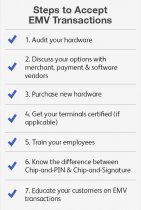Intuit QuickBooks Point of Sale update
In case you haven’t heard, the EMV migration is coming. EMV is a security standard put forth by the world’s major credit-card brands, and it’s already appearing on your customers’ cards in the form of a “smart chip.” This article is intended to walk you through the steps of migrating to the new processing standard, but for more background on everything EMV, check out our EMV infographic.
As opposed to the old magnetic-stripe cards, EMV chips offer a higher degree of security throughout the transaction process, which aims to substantially reduce U.S. credit-card fraud.
In an effort to facilitate the migration, card issuers are adding incentives for small businesses that make the move. Beginning October 1, 2015, the big four credit-card brands (i.e. Visa, MasterCard, American Express and Discover) are making a “liability shift” from the credit card’s issuer (i.e. a bank or large firm) to your business in the event of certain types of credit-card fraud.
If your business doesn’t have the newer, EMV-enabled hardware installed and isn’t ready to accept EMV transactions, then your business will be responsible for fraudulent charges.
If that got your attention, and you’re looking for a one-stop shop on how to properly migrate your business to accepting EMV payments, look no further. Here are the steps to successfully migrate your business to accepting EMV payments.

1. Audit Your Hardware
Take a look at your existing payment-processing hardware. Do you have simple, stand-alone terminals? Do you have a “canned” or “drop-in” solution that works with your existing cash register or point-of-sale (POS) terminal?
Make a list of your current hardware, so you can compare apples to apples when buying new hardware.
- TIP: If you’re considering a hardware upgrade to accept mobile payments, then now might be the time to do so. Why upgrade twice in the next five years at twice the cost when you can do it once and be done?
2. Discuss Your EMV Hardware Options With Your Merchant Acquirer, Payment Processor and (If Required) Independent Software Vendor (ISV)
Your business’ merchant acquirer can help guide you to payment processors that they work with, who in turn can recommend solutions that fit your business.
If your business uses a heavily customized POS, then your ISV should be involved in any equipment purchase, as they will have an important role to play in EMV Certification.
3. Purchase Your New Hardware
This will likely be done through your payment processor or a recommended technology vendor. If you have any last-minute questions about your new hardware, these are also the parties to ask.
Related posts:

 If you already have a PC and are looking to convert it to a full POS System, a bundled POS Kit is a fantastic option. Having a POS System at your business can…
If you already have a PC and are looking to convert it to a full POS System, a bundled POS Kit is a fantastic option. Having a POS System at your business can… Most of this is the Aloha default setup.NETWORK SETUP workgroup = ibertech servername = alohaboh Static IP Scheme ex 192.168.1.100 NetBIOS must be enabled over…
Most of this is the Aloha default setup.NETWORK SETUP workgroup = ibertech servername = alohaboh Static IP Scheme ex 192.168.1.100 NetBIOS must be enabled over… *Receive the stated discounted price for this year’s version of the product selected, available for a limited time if purchased through Intuit. Free shipping…
*Receive the stated discounted price for this year’s version of the product selected, available for a limited time if purchased through Intuit. Free shipping… Join millions of philatelists (or stamp collectors) in collecting, displaying and enjoying Canadian stamps. We take pride in producing beautiful and…
Join millions of philatelists (or stamp collectors) in collecting, displaying and enjoying Canadian stamps. We take pride in producing beautiful and… Allentown, PA-based point-of-sale (POS) vendor Harbortouch has disclosed a data breach affecting “a small number” of merchants using its systems. Brian Krebs,…
Allentown, PA-based point-of-sale (POS) vendor Harbortouch has disclosed a data breach affecting “a small number” of merchants using its systems. Brian Krebs,… Trust is the reason new businesses open accounts with us. Trust is the reason clients stay with us. And trust is the reason they refer their colleagues to us.…
Trust is the reason new businesses open accounts with us. Trust is the reason clients stay with us. And trust is the reason they refer their colleagues to us.…